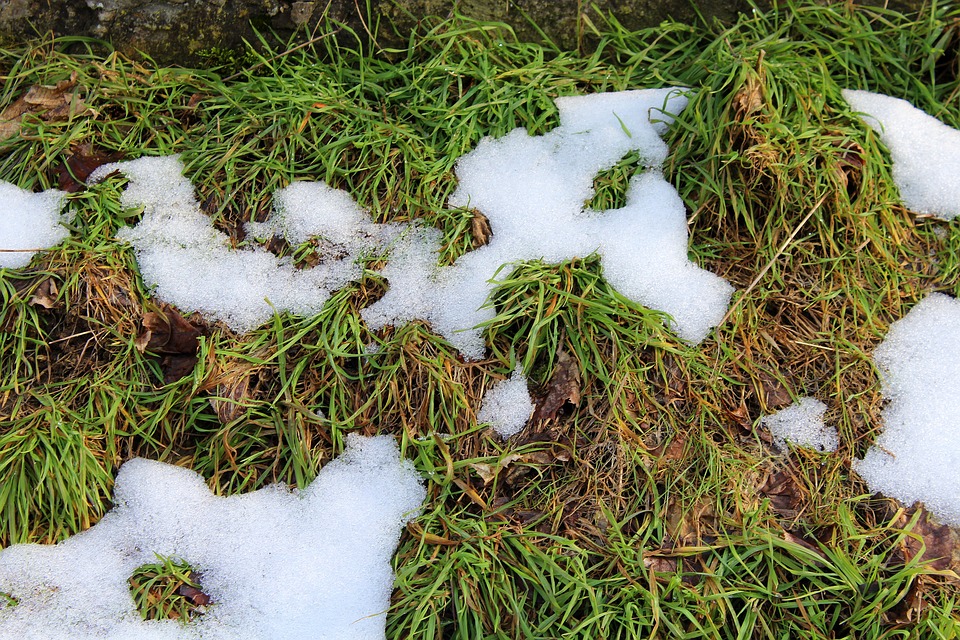
Regardless of whether your lawn handled winter’s wrath like a champ, or is looking a little worse for the wear, we have your spring lawn care guide to keep your Scranton lawn thriving well into the summer months.
1. Get in Some Spring Cleaning
It’s time to spruce up that lawn after a long, cold winter. You don’t need to do much, but you should take some steps to promote your lawn’s growth after the drawn out periods of cold dormancy it just experienced.
If you find that you still have random patches of snow on your lawn, you can expedite the snow melting process yourself. All you need to do is rake the piles of snow into more uniform, evenly distributed areas. Doing so will help it melt quicker and prevent large bald spots from appearing on your lawn.
 You will also need to remove any leaves or branches that appeared on your lawn during the winter or late fall months. You can rake or blow these items off your grass, but the main idea here is to get rid of excess debris that would otherwise prevent your grass from growing.
You will also need to remove any leaves or branches that appeared on your lawn during the winter or late fall months. You can rake or blow these items off your grass, but the main idea here is to get rid of excess debris that would otherwise prevent your grass from growing.
2. Mow the Lawn As Soon As Possible
There’s no need to hurry things along, but once the weather has warmed, you should prioritize time to cut your grass. Grass that’s too long can shade newly developing seedlings and prevent new growth from emerging. On the flip side, try not to cut too much, or it will turn the lawn yellow and hinder growth. The roots won’t have enough time to become established, and the blades of grass need time to store energy before they are cut short.
3. Overseed in Late Spring
Wait until late spring to overseed. This technique will ensure that ground temperatures are warm enough to support the germination process, and will also prevent your seeds from getting washed away by melting snow and groundwater. If you are applying a pre-emergent herbicide, such as crabgrass control, you will need to wait a few weeks after this process to prevent your herbicide from killing any new grass.
4. Get Those Weeds Under Control
If you didn’t apply a pre-emergent herbicide in the fall, now is the time to do so. You can apply a herbicide in early spring before weeds like crabgrass emerge so that you aren’t left fighting with them throughout the winter. While you can always resort to manually removing weeds, dealing with them before they appear is a much easier process.
 The best time to apply crabgrass control is about ten to fourteen days before the expected spring germination period. Crabgrass germinates when the soil reaches 55 degrees Fahrenheit for nearly a week straight. Therefore, you’ll want to plan ahead to time your herbicide applications faultlessly.
The best time to apply crabgrass control is about ten to fourteen days before the expected spring germination period. Crabgrass germinates when the soil reaches 55 degrees Fahrenheit for nearly a week straight. Therefore, you’ll want to plan ahead to time your herbicide applications faultlessly.
5. Restart Your Irrigation Routine
Your lawn needs about an inch of water per week, less of course during wet periods, as well as when temperatures are naturally cooler. Water thoroughly and deeply, taking care not to spritz over areas but to soak the roots of the grass. Consider installing an irrigation system in the spring, as this will reduce the amount of time you need to spend watering your lawn throughout the hot summer months. You can even install a rain gauge to keep track of precipitation so that you know when irrigation is necessary, and when you can hold off.
6. Take Steps to Prevent Disease
The easiest way to treat a disease outbreak is to prevent it from gaining a foothold. An infection will not occur unless environmental conditions are conducive. To prevent disease, make sure your lawn is even and doesn’t have bald spots. Uneven distribution of vegetation can allow disease to take hold in vulnerable areas. Make sure shaded areas aren’t prone to puddling, and always remove any dead or decaying vegetation from the lawn to prevent mold growth.
7. Dethatch and Aerate Your Lawn
 Aerating a lawn helps to reduce compaction that may have occurred throughout the winter, whether it was caused by excessive foot traffic, heavy snowfall, or both. Aerating your lawn will allow water, nutrients, and oxygen to reach your grass’ hungry roots. You can rent an aerator from a local farm and garden store knocking this task out in a few hours. Dethatching is the process of removing thatch (or built-up debris) which will also help allow your grass to breathe.
Aerating a lawn helps to reduce compaction that may have occurred throughout the winter, whether it was caused by excessive foot traffic, heavy snowfall, or both. Aerating your lawn will allow water, nutrients, and oxygen to reach your grass’ hungry roots. You can rent an aerator from a local farm and garden store knocking this task out in a few hours. Dethatching is the process of removing thatch (or built-up debris) which will also help allow your grass to breathe.
Need help tending to your lawn? Visit our Scranton lawn care page for more info!
Feature image source: Zillow.com